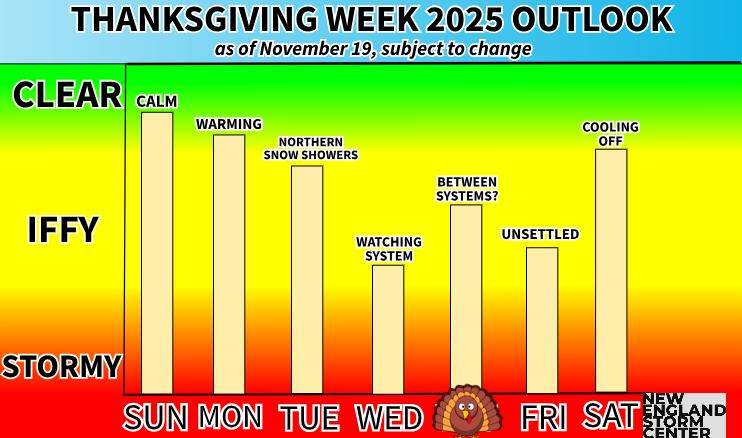Heat Gives Way to a Stretch of Unsettled Weather for New England
- Tim Dennis
- Jun 26
- 3 min read
The full relief from the heat has arrived as a cold front has cleared the region. This boundary will remain to the south of New England, remaining nearly stationary, through the rest of the week. Multiple waves of energy will traverse the boundary, bringing plenty of clouds and scattered showers through Saturday. For Thursday, showers will likely remain widely scattered with many areas remaining dry. Friday will be a near carbon-copy of Thursday, though increased showers will gradually begin to move into northern New England later Friday.

The most organized of these waves will likely cross New England later Friday through Saturday. While there's a spread in exactly where the boundary will be set up, it continues to look like northern New England will see better forcing for showers, leading to wetter conditions the farther north in New England you go (outside of northern Maine), with amounts gradually tapering moving southward. With that said, all of New England is apt to get wet weather, with at least a half inch in the forecast for everyone but northern Maine.

Areas which see the greatest forcing for showers will be favored to see scattered torrential downpours later Friday into Saturday. Again, this looks to be across the northern tier of New England. There remains a large spread in just where the frontal boundary and low pressure system will track. The heaviest and more widespread rain potential will likely occur on the north side of the area of low pressure, along its warm front.
As of now, current trends favor 1.5-3 inches of rain across northern Vermont and New Hampshire, with some pockets of 4 inches possible. The threat of torrential downpours may lead to varied rainfall amounts across the region. Northern Maine and southern New England will be further removed from the strongest forcing, so amounts will likely taper off in these areas.
Below: Current precipitation forecast through Sunday morning:

There are a few factors that may line up to bring northern Vermont and New Hampshire rounds of heavy rainfall. A thermal boundary set up across the area (in the form of the frontal boundary) with an unseasonably strong jet streak set up across southern Canada. The location of this jet streak would put the northern tier of New England in a favorable position to see rising air and upper-level divergence, which would help enhance rainfall. Moisture-content will be very high as well, with precipitable water values (a measure of moisture in the atmosphere) well over 1 inch, indicating a moisture-rich environment.
These factors may line up to create the potential for downpours and localized flash flooding across northern New England. Stream-flows are currently near-normal, so there is room within rivers for some runoff, so widespread river flooding is not expected. The potential for some flash flooding across northern Vermont and New Hampshire will be the main concern in this regard. With this said, there remains a spread in guidance on just where the heaviest axis of rain will occur, and it could even be pushed into southern Canada, so this threat could decrease or increase in the next 24 hours. Trends will be watched.

Some of the issues that lower confidence on the overall outcome of this event include the fact that a rather narrow band of strongest forcing will likely be present near the frontal boundary. Exactly where this sets up over northern New England is very difficult to pin down. With convection involved, rainfall amounts will likely end up highly varied, as mentioned before.
If the warmer air is pushed farther north than currently anticipated due to strengthening of the low-level jet, the heaviest rainfall would be pushed into southern Canada rather than northern Vermont/New Hampshire. This would result in more scattered showers and thunderstorms over New England rather than a period of steady to heavy rain, thus lowering rainfall amounts. These are the main factors that will be watched in regards to trends over the next 24 hours or so.
Below: Two model runs, one showing the axis of heaviest rainfall moving into northern New England while the other keeps it across southern Canada:
The basic timing of this system will likely see showers increase in coverage later Friday into Friday night. These showers will spread from north to south through the day on Saturday. Showers may linger into Saturday night or Sunday morning before diminishing during the day Sunday.
Early next week, a Bermuda high looks to build back, bringing a warming trend with widespread 80s and higher humidity back into the picture. At this point, another heat wave is unlikely, but temperatures will be building back up next week. The next chance for showers or thunderstorms will come on Tuesday (July 1).







Comments